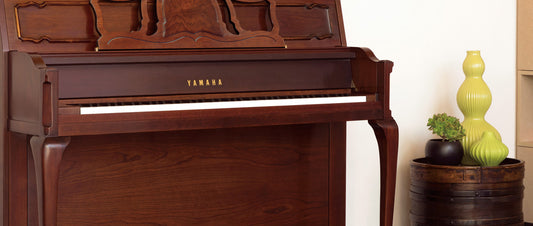


Mr. Paul Reed Smith in his Wood Library
PRS was officially founded in 1985. Unfortunately, by the mid-80s, many of the world’s most well- loved and influential electric guitar players found their way to an untimely death. It’s also true that many Classic Rock and Electric Blues era bands lost a key member or dissolved entirely before the “PRS era.”
Q. Alto Music: If it were possible to go back in time and deliver a PRS Electric guitar to any guitarist alive during the solid body era, who are a few players you’d have loved to see with a PRS, and what model might you choose for them? How about a Polar Blue Silver Sky for Buddy Holly to chop out the groove on ‘Peggy Sue’? Maybe you’d have liked to see Mick Ronson “jamming good” with Ziggy Stardust and the Spiders from Mars on a PRS 513? You get the idea, and we want to know!
A. Paul Reed Smith: I would have loved to have met Hendrix; he was very open to new devices that would help him do his job. I made a guitar for Jeff Beck, which he and I were both very private about. Would I change history? No. Do I fight a war that our guitars didn’t exist when some of these iconic tracks were cut? Yes. Are there guitar players that I adore their musicianship that I hope or hoped someday would try a PRS? Yes. This is our time. I’m ok.

One of Carlos Santana's first PRS Guitars
At one time or another, every serious electric guitarist will run across an instrument they feel an overwhelming, instant connection with. A special guitar that delivers cold sweats and a love-at-first- sight, lifetime bond.
Q. Alto Music: What was the first Guitar made with your own two hands that you had a ‘magical’ and instant connection with—The one that can make the hair on the back of your neck stand up?
A. Paul Reed Smith: The first guitar that made a connection with me was the guitar I made for Peter Frampton early in my career. Very few guitars have either welled me up or made the hair stand up on my arms, but the first guitar that I made for Carlos Santana, I knew it was magic when I sent it on its way to do its job. The first twenty guitars that we brought to NAMM were in the hold of the airplane, and we knew it was going to be a good week. Watching John McLaughlin touch his instrument for the first time – a whole group of us watched – it was magic. He said, “Oh no. I love it.” Now, a guitar that made me well up was the first black spruce top 15” wide Hollowbody with a Floyd Rose that we made for Neal Schon. I called Neal and said, “This thing welled me up.” He said, “Send it.” We just made a guitar that the pickups sound beautiful, and I got welled up over that. So it’s still happening when deserved.

Mark Lettieri with his Signature Model PRS Fiore
During the 90s and early 2000s, “PRS guitar’s” popularity went through the roof with NU Metal players. Although the association was very strong, PRS has managed not to become pigeonholed as a “90s Metal” Guitar or get stuck in the “genre association” trap.
Q. Alto Music: After 40 years of constant popularity, what have you learned about keeping PRS fresh and exciting from generation to generation?
A. Paul Reed Smith: We do not see ourselves as a brand, but that is happening organically in the market. We see ourselves as instrument makers, making tools for musicians to make their music. You’ve got to remember that Telecasters were used for both jazz and country and blues – Danny Gatton somehow got it to work for all three ’cause he was so good. So, in my mind, the Hollowbody could be used in a metal band – as Emil Werstler did in Chimaira. It’s a tool to do a job. Pro-tools can record any kind of music. So, we’ve stuck to our instrument-making knitting.

2005 20TH Anniversary PRS Dragon
Nearly every website that covers PRS rightly mentions the beautifully inlaid Dragon guitar that came to a young Paul Reed Smith in a dream, but not much else about the Dragon’s origin. So far, PRS has created 9 stunningly beautiful, highly collectible Dragon inlaid guitars. PRS also created Dragon pickups, Paul’s band is named “The Dragons,” and several Dragon statues watch over Paul’s home recording studio loft. Surely, the Dragon has a special meaning for Paul, but little has been said or written about his admiration of the mythological beast.
Q. Alto Music: We love them also, but why Dragons? Why not Evil Robots or something? What can you tell us about why the Dragon has become the ‘unofficial’ fire-breathing mascot of PRS?
A. Paul Reed Smith: I don’t know – I just always liked English water dragons ‘cause they look like they could fly. The movie with Matthew McConaughey called Reign or Fire depicts it very well. I also thought that a dragon slayer going out to kill the dragon for the maiden was a bunch of crap. The dragon opened his mouth and killed the guy instantly. When we did the first dragon fretboard, I couldn’t get any orders, and the person running our sales department refused to sell them. It gave me one of the most powerful migraines of my life. I had a clipboard with 50 spaces for orders, with only three spaces filled. I went to Greg Bayles from Make’N’Music in Chicago, and said, “C’mon Greg. Order some dragons.” He ordered eight, and we were off to the races. Yay!

Just a few of many PRS finish colors hanging out to dry
From day one, PRS stunned the world with some of the most explosive 3-D curly maple tops and unusual eye-catching finishes never seen on a guitar before. From 1986-1990, PRS offered over 20 individual finish choices, including Whale Blue, Scarlet Red, Grey Black, Emerald Green, Teel, and more. Many PRS fans will know that the rare, early ‘Bonnie Pink’ finish was inspired by the Bathroom tile choice of a PRS employee named Bonnie.
Q. Alto Music: Aside from a few traditional colors and sunbursts, are all PRS colors fabricated/created on sight? Going on 40 years, so many popular new colors have come out of PRS that you’ve extended the range of colors that guitarists now expect. We are not asking for PRS trade secrets, but we’d like to know where the inspiration for new and untried colors comes from and if you have ever been surprised by the popularity of a color you weren’t 100% sure about.
Paul Reed Smith: All the colors are done onsite, and we let employees come up with colors regardless of their position. Three that really surprised me were: Somebody sent us a purple balloon and said, “Blow it up and hold it up to the light. That’s the color I want it.” That worked.

Paul and Ted at PRS (Early 90s)
The internet has dramatically changed how the enthusiastic Guitarist learns and thinks about all things Guitar-related. The internet can provide remarkable insights and knowledge, but it also broadcasts unbridled quackery in equal measure—understanding one from the other can be difficult- especially without much experience.
Q. Alto Music: You have natural talent, ambition, and drive, and you even managed to track down Ted McCarty to help finish and fine-tune your education before the internet was available. That being said, what would you recommend to up-and-coming guitar makers about the ups and downs of internet learning?
A. Paul Reed Smith: Go to every vintage tradeshow you can and pick up guitars that the masters of our industry built and try to understand what they did and, what they were thinking. Most of them have passed away, but what they thought the day they made it is in that instrument and will talk to you. Look, if a musician has a boat full of guitars, these new builders need to study why the musician picks up one guitar in preference over another one. They need to listen – not talk. Fascinating!
-

The Impact of the Moog Theremin: A Brief History
The Theremin was invented around 1920 by Soviet Russian Scientist Leon Theremin. His creation was probably the first musical instrument that had no “acoustic” ancestors and definitely the first musical...
The Impact of the Moog Theremin: A Brief History
The Theremin was invented around 1920 by Soviet Russian Scientist Leon Theremin. His creation was probably the first musical instrument that had no “acoustic” ancestors and definitely the first musical...
-

Choosing the Right Gibson Acoustic
Choosing a Gibson was your first great move. Every Gibson acoustic guitar made today, is a direct descendant of the groundbreaking designs of the 30’s through the 60’s. Gibson has...
Choosing the Right Gibson Acoustic
Choosing a Gibson was your first great move. Every Gibson acoustic guitar made today, is a direct descendant of the groundbreaking designs of the 30’s through the 60’s. Gibson has...
-

Yamaha Musical Instruments: Empowering Music Cr...
Torakusu Yamaha the businessman, engineer, traditional and progressive minded genius made himself and the world a promise. He will bring the power and means to make music Traditional value and craftsmanship working...
Yamaha Musical Instruments: Empowering Music Cr...
Torakusu Yamaha the businessman, engineer, traditional and progressive minded genius made himself and the world a promise. He will bring the power and means to make music Traditional value and craftsmanship working...



